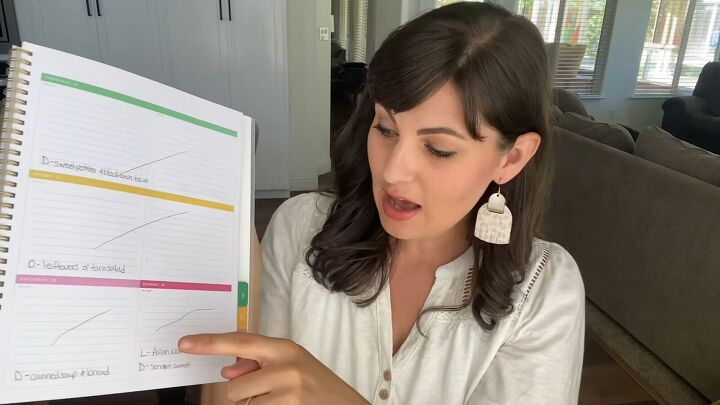5 Quick and Simple Tips for Grocery Shopping on a Budget

If you are new to budgeting and want to start grocery shopping on a budget and do not know where to begin, this article is for you.
Budgeting is fun, because it is so freeing, so I am excited for you to start. Let’s talk about the basics of how to grocery shop on a budget.
1. Create a grocery budget
The grocery budget can totally keep you on track or completely derail you from hitting your financial goals. Look over your past bank statements to see how much money you have actually been spending at the grocery store or eating out.
When we are only starting, we might easily fall into the trap of thinking we can stick to a really low grocery budget and hit really high financial goals. However, you have to remember that the first three months of budgeting are the most difficult.
Once you get through those three months, then you can reevaluate your grocery budget, and you can do that on a regular basis. Your life changes, so you cannot expect yourself to stick with the same number every month. For example, I lower my budget in the winter, when I have my winter garden and need to buy less produce.
If you are just starting out and have never budgeted before, I would recommend budgeting between $40 and $50 per person per week in the beginning. Now, for my family, we do about $25 to $30 per person per week, or lower when we are focused on paying off debt.
Remember: this is your first month, so you want to win. Make sure your grocery budget is realistic so you can succeed. Whatever you come up with for your grocery budget for this month, add at least $50 or $100 to that budget.
2. Pull cash
If you are not going to pull cash for any other category, you have to do it for groceries, at least for the first couple of months. You can always redeposit the cash if you choose to do an online Instacart or Walmart grocery pickup, but it is important to pull cash in the first months in order to see where the money is going.
It is so easy to get caught up in little midweek trips to the grocery store, and before you know it, it is the end of the month and you have run out of money.
To prevent this from happening, I suggest breaking up your grocery budget into four weeks of groceries and sorting the cash that way. Then, you will still have the money for grocery shopping in the last week of the month.
Another tip that I use is breaking the money up. Out of $600 a month, I only want to spend $100 a week on groceries, leaving around $200 for bulk foods – items I consistently buy in bulk. Those will be different depending on what your household staples are, but for us those are oats, flour, salt, honey, maple syrup, etc.
We always need those in the house, so I buy them in bulk every month. Azure Standard is my personal favorite for bulk shopping.
3. Meal plan
You are not going to like me for this one, but I promise it works. Meal planning prevents you from eating out spontaneously or wasting food.
Take out your planner and plan what you are going to do the next week. You do not have to stick to this exact menu, but do pick seven of your favorite dinner ideas. I recommend looking at your planner from last month and seeing what worked well. This way, you will be able to rotate the different meals that you eat on a consistent basis.
I also suggest keeping a recipe binder to help you menu plan and grocery shop easily. One of my favorite ways to meal plan is to go to the library and check out cookbooks. Those give me great ideas, which I then put in my recipe binder.
4. Make a grocery list
Before going to the store, always make a grocery list. A budget grocery list gives you a clear focus of what you are there to do and lets you know exactly how much you are going to spend.
After creating a menu, get a notebook and write down everything you need to get for the week. The next step is often missed, but it really helps stick to your budget: always estimate how much each item is going to cost and calculate the estimated total. This way, you will always know about how much you are going to spend on groceries and will never be surprised.
5. Stick to the plan
Do not deviate from the plan. If you do realize that you want something different for dinner tonight, look through your pantry and build something from what you already own.
For example, a few weeks ago I did not feel like spaghetti and meatballs that I had planned for dinner, and decided instead to make Asian bowls, for which I already had all the ingredients, so it did not affect the rest of my menu for the week. We had spaghetti the following week.
The important part is to stick to the plan as much as possible, at least for dinners. I do not typically plan breakfast, but I have picked five breakfasts that my family loves, and we repeat them. Lunches are definitely something to plan during the school year, but when the kids are home with me, we eat a lot of leftovers at lunch.
However, staying consistent with your dinners is paramount if you want to stay true to your budget. Just be diligent and focused and keep your financial goals in mind, because they are what gets you motivated to work.
Grocery shopping on a budget
This is my simple guide to buying groceries on a budget. Trust me, budgeting is a game changer. It opens up opportunities you would not even think possible. So dream big and budget!
Do you already have a grocery budget? How is it working out for you? Do you have any great tips to share? Leave a comment below!





















Comments
Join the conversation